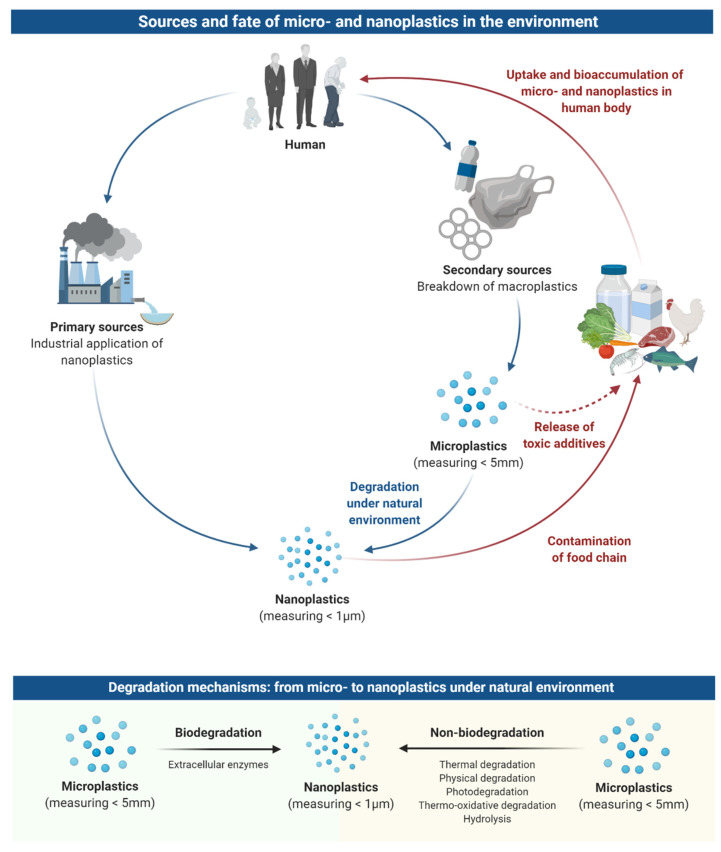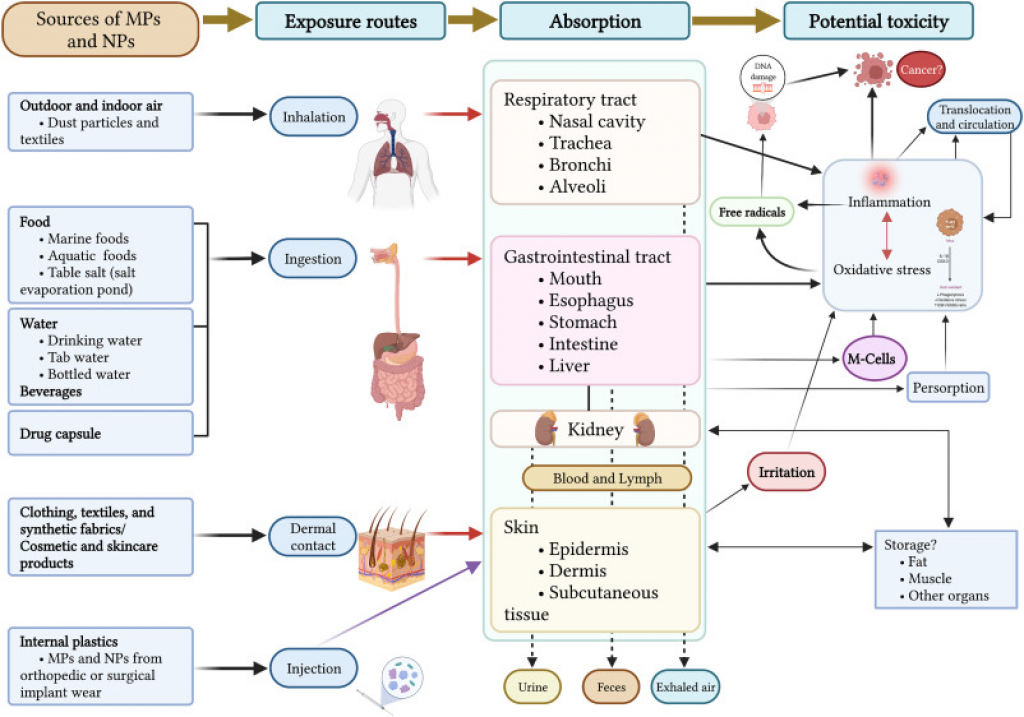Description

Disclaimer: Copyright infringement is not intended.
Context:
- Research has identified three exposure pathways and multiple impacts of microplastics and nanoplastics on humans.
What are microplastics and nanoplastics:
- The term microplastics refers to pieces of plastic that are smaller than 0.5mm in diameter, which is roughly equivalent to a grain of rice. Meanwhile, nanoplastics are far smaller, at just 100 nanometres or less.
Sources of microplastics:
- Over 80% of microplastics are produced on land, with less than 20% originating from the sea. As microplastics are uniquely light, indestructible, and able to float, they can travel far across the globe.
- Micro- and nanoplastics are generated from both primary and secondary sources.
- Primary sources: They are those that deliberately created micro- and nanoplastics for consumer and industrial uses, such as exfoliants in cleansers, cosmetics, drug delivery particles in medicines, and industrial air blasting.
- Secondary sources: Macroplastic products that disintegrate into micron-sized and smaller particles are the secondary source of micro- and nanoplastics; they occur both terrestrially and in the aquatic environment.

Exposure Pathways
- Research has identified three major routes through which microplastics and nanoplastics can enter the human body: Ingestion, inhalation, and dermal contact.
- Ingestion
- Ingestion, or oral consumption, is a primary route for exposure to microplastics and nanoplastics. These particles have been detected in various food and water sources, including drinking water, seafood, salt, bottled water, and even tea and coffee. Studies have found microplastics in fish, mussels, and salts from lakes and oceans, as well as in commercial salts and bottled water.
- Polyethylene terephthalate (PET) and polypropylene (PP) are among the most commonly reported polymers in bottled water. Additionally, tap water has been found to contain microplastics in both developed and developing countries. Even seemingly innocuous items like teabags, coffee, and food products have been found to contain microplastics, illustrating the pervasive nature of this contamination
- Inhalation
- Inhalation, or breathing, is another significant route of exposure to MPs and NPs. These particles have been detected in the ambient air, with outdoor and indoor concentrations varying depending on location and environmental factors.
- Sources of airborne microplastics include synthetic textiles, industrial emissions, solid waste dumping sites, and agricultural activities. Sea breeze and sea spray near coastal areas also contribute to atmospheric microplastic pollution.
- Inhalation of microplastics may lead to their accumulation in the respiratory tract and potential translocation across the blood-brain barrier, raising concerns about respiratory and neurological health effects.
- Dermal Contact
- Dermal contact, or skin exposure, is another route through which individuals may be exposed to microplastics and nanoplastics. Consumer products such as face creams, face washes, and cosmetics can contain microplastics, increasing the risk of dermal exposure.
- While absorption through the skin is unlikely due to the physicochemical properties of microplastics, deposition on the skin and potential absorption of nanoparticles raise concerns about skin exposure. Studies have suggested that microfibers and particles from cosmetics and toothpaste may be absorbed by the skin, indicating a need for further investigation into their potential health effects.

Potential health risks of microplastics:
Gastrointestinal and urinary tract system
- Exposure to microplastics and nanoplastics via ingestion can lead to their translocation through the gastrointestinal tract and potential accumulation in tissues. Studies have shown that these particles may cause oxidative stress, inflammation, and histological changes in the intestines of animals.
- Furthermore, exposure to microplastics has been associated with immune system dysregulation and metabolic disorders, raising concerns about their long-term health effects.
Respiratory tract system
- Inhalation of microplastics and nanoplastics can lead to their accumulation in the respiratory tract, potentially causing irritation, inflammation, and oxidative stress. Research suggests that exposure to these particles may worsen respiratory symptoms and contribute to the development of respiratory disorders.
- Additionally, the size and concentration of microplastics can affect their toxicological impact on lung cells, emphasizing the need for further research into respiratory health risks.
Blood and immune system
- Exposure to microplastics and nanoplastics has been shown to affect immune cell function and cytokine production in animal studies. Changes in serum levels and immune cell activity have been observed following exposure to these particles, suggesting potential systemic effects.
- Furthermore, the presence of microplastics in lymph nodes and blood circulation raises concerns about their long-term impact on immune function and overall health.
Brain and nervous system
- Studies have suggested that microplastics and nanoplastics may have neurotoxic effects, leading to oxidative stress, cytotoxicity, and changes in neurotransmitter levels.
- Exposure to these particles has been linked to cellular damage and inflammation in brain tissue, raising concerns about their potential role in the development of neurological disorders. Moreover, the ability of nanoparticles to cross the blood-brain barrier underscores the need for further research into their neurotoxic effects.
Embryos and placental barrier
- The presence of microplastics in the placenta and foetal tissues raises concerns about their potential impact on foetal development and pregnancy outcomes. Studies have shown that microplastics can cross the placental barrier and accumulate in foetal tissues, potentially leading to developmental abnormalities and embryotoxicity.
- Additionally, exposure to microplastics during pregnancy may have long-term implications for the health of both the mother and the developing foetus, highlighting the need for further research in this area.
Way Ahead:
- It is crucial to continue efforts to understand the sources, pathways, and health implications of microplastics and nanoplastics to develop effective mitigation strategies and protect public health.
- Addressing this issue requires a comprehensive approach that includes reducing plastic waste at its source, improving waste management practices, and finding innovative solutions for the removal of microplastics from the environment.
- Policy shifts can reduce plastic pollution by incentivizing changes in both business and consumer behavior, as well as in plastic design, alternatives and recycling.
The 3R’s +E Strategy:
- Reduce: To efficiently reduce plastic pollution, there is an evident need of reducing our usage of plastic.
- Reuse: Many plastic items can be reused or used for different purposes. Before throwing plastic items, it is important to consider how they can be reused.
- Recycle: Plastic recycling consists of collecting plastic waste and reprocessing it into new products, to reduce the amount of plastic in the waste stream.
- Educate: Another crucial solution is education in order to increase awareness and behavioral change.
- By raising awareness, implementing robust policies, and adopting sustainable practices, we can mitigate the threats posed by microplastic contamination and ensure the well-being of future generations.
Conclusion:
- The presence of microplastics and nanoplastics in our environment, along with their potential impact on human health, is a matter of increasing concern. Although ongoing research is providing more information on the health effects of these particles, evidence suggests that exposure to microplastics and nanoplastics could pose significant risks to various organ systems and physiological processes within the human body.
Source:
Down to Earth
|
PRACTICE QUESTION
Q) Discuss the exposure pathways and potential health risks associated with microplastics and nanoplastics, emphasizing their ingestion, inhalation, and dermal contact. Also, elaborate on the key areas of concern regarding health risks and propose a comprehensive strategy to address the issue. ( 250 Words)
|














